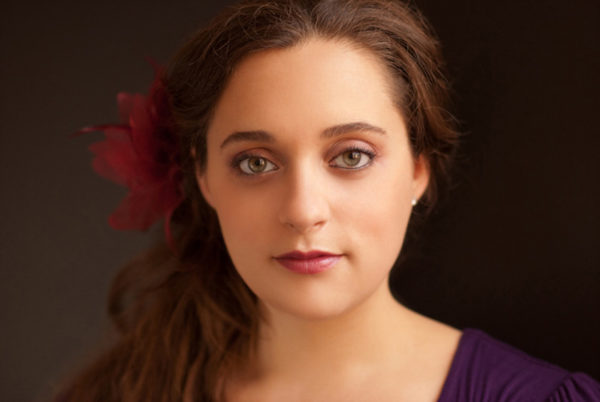Concert Review: Henry Purcell Society — The Delights of Going Mad
By Nate Beyer
The Henry Purcell Society proves that playing mad can be a lot of fun.

Soprano Teresa Wakim. Photo: courtesy of the Henry Purcell Society.
“I burn, I burn,” sang soprano Teresa Wakim, her voice soaring to the top of the vaulted ceiling at St. Paul’s Episcopal Church in Brookline during the Henry Purcell Society’s recent concert Mad Songs, Dialogues, and Trios. Her voice then plunged down, its tone undulating like flames licking the building’s wooden beams. This was a masterful interpretation of an English Restoration period “mad song,” Thomas D’Urfey’s “A Song by a Mad Lady: I Burn, My Brain Consumes to Ashes.”
Coming out of a period of bloody civil war and Puritan-influenced rule, and with the monarchy of Charles II restored, England became fascinated by tales of madness. One of the first psychiatric hospitals in the English-speaking world was London’s Bethlem Royal Hospital (cockney-ized into “Bedlam,” which inspired the word for uproar and confusion). The good governors of the institution even saw fit, beginning in the early 1600s, to admit anyone in for a “show” (a gander at the patients) at a few pence per head. By Purcell’s day, at the end of the 17th century, an appetite for stories of the mad had become fodder for song as well as a topic for the stage.
The Purcell Society’s concert alternated mad songs with Baroque trio sonatas by Purcell and his contemporary William Boyce. In tandem, the two styles hopped between music meant for the parlor and for the pub. In the opening, Purcell’s instrumental Fantasia, the musicians deftly traded the melody line as it flowed from the recorder to the violins, then to the harpsichord and back around. It was almost the way a jazz quartet might take turns trading solos. Fantasia, and the other sonatas by Boyce and Purcell, usher the listener into a highly structured world of rich contrapuntal arrangements that would come to full fruition decades later with the works of Bach.
What the mad songs lack in complex instrumentation, they make up for in humor and passion. To paraphrase one of the tunes on the program, “‘Tis love that makes us mad,” and indeed, most of the madness represented on this program had its roots in love gone wrong (how little has changed). The program also featured incidental music from period dramas, interludes where dialogue was sung rather than spoken. In a Purcell setting of a dialogue from the short fiction Oroonoko by Aphra Behn, adapted for the stage by Thomas Southerne, Wakim and fellow soprano MaryRuth Low n bent genders as a pair of would-be lovers. Beating hearts and heaving breasts dominate the piece, and both women did a wonderful job of keeping tongue firmly in cheek. Of course, Southerne’s audience would have thrilled to see two women in the scene, given that the Restoration stage allowed women — not young men or boys — to play female roles.
The stars of the afternoon were the singers, particularly Wakim. Her warm, multihued voice is capable of every Baroque ruffle and riff, trill and lull. She captured subtle shifts in tone and dynamic, finding complicating nuance, always singing with evident delight, even when she was asking for the aid of the supernatural to get out of a tight spot: “Grim King of the Ghosts, be true and hurry me hence away.” Lown’s performance was also strong, duetting with Jacob Cooper in a selection from a Purcell setting of a Thomas Betterton dialogue. “How gladly we believe,” they sang together, “when the heart is too willing; Can that look, that face deceive?” Cooper was solid throughout — all three seem to be having an awful lot of fun being mad.
The musicians were generally strong. Andrus Madsen played a harpsichord that looks like something out of a Restoration drawing room. His performance was deft; he had to handle alternating duties as melody player and timekeeper via hitting percussive staccato notes. On violin, Susanna Ogata swam through the ornate Baroque phrasing with aplomb, and Emily Dahl Irons jumped in with vigor. There may have been one or two moments where the two did not land squarely where the composer had envisioned — but these were minor missteps. Colleen McGary-Smith provided a firm spine on cello, and Catherine Liddell played a theorbo, an oversized lute that looks as though it could have been designed by an early-music Jimmy Page. Liddell also supplied a beautiful small early guitar in several pieces. Dan Meyers and Roy Sansom, on recorders and various percussion instruments, added color and flair, floating with ease between the highbrow and popular lowbrow. Sansom’s mouth harp (or Jew’s Harp, if you must — perhaps the most humble instrument in the Western canon) emitted a kind of clarion call during the first mad song of the concert — the sound announced the arrival of different world. You knew you weren’t in no drawing room any longer. As the lower classes knew, playing mad can be a lot of fun.
Nate Beyer is a writer and educator, and winner of the St Botolph Foundation Emerging Artist Award. His work has appeared in Dark Sky Magazine, the Arts Fuse, the Adirondack Review, and in print in Attache, the in flight magazine of US Airways. Contact him at nateb123@gmail.com.
Tagged: Henry Purcell Society, Mad Songs, Mad Songs Dialogues and Trios, Nate Beyer


Most evocative classical concert review I’ve read in some time! I felt like I could almost hear harmonious bursts of ancient map-cap song.